By Cami Adams
The hot summer months are here and with them comes another pest. Between the months of April and November, Florida residents may encounter high populations of aquatic midges, also known as “blind mosquitoes”. Homeowners venturing outside may unexpectedly find them resting in the thousands on the sides of their houses, patios, and vegetation/landscaping. “Blind mosquitoes” prefer cool, shady places to rest during the day and gravitate to the lights around residencies and businesses at night. When they emerge in large numbers, they can stain paint finishes and have been known to fly inside homes and rest on interior walls. Yet, for as annually as they appear, these pests are frequently misunderstood by the public.

Oftentimes, aquatic midges are mistaken for mosquitoes, likely due to their moniker. Unlike their blood-sucking counterparts, however, aquatic midges do not bite, feed on blood, or carry diseases. In fact, the adults that love to annoy us only emerge to reproduce and do not eat for the three – seven days that they are alive. During this time, females lay egg masses on the surfaces of ponds, lakes, or rivers where they sink and hatch two -seven days later. Larvae emerge to feed on organic matter suspended in the water and on the water body floor, molting as they grow. The final molting stage before the pupal stage creates larvae pink to red in color that are commonly used by many fishermen as bait called “bloodworms.” Adults emerge from pupae, completing the life cycle in approximately two weeks.
Control of aquatic midges is challenging and costly because larvae thrive on the floor of whatever water body they occupy. The entire water column must be treated to ensure the product reaches the larvae. While this is possible for small lakes and ponds, it is ineffective in most scenarios. Additionally, treatment must be applied at eight-ten times the normal application rate used for mosquito larvae. With large-scale control not a viable option, residents must find other means to keep these nuisances at bay. If the midges are coming from a residentially-owned water source, native fish can be added to reduce larval populations. Additionally, native vegetation can also be planted along the water’s edge to help remove excess nutrients and minimize food sources for the midges. Keeping yard waste and grass clippings away from the water and creating a ten-foot unfertilized no-maintenance zone prevents excess nutrients from entering the water.
If aquatic control is not feasible for residents, there are still options to limit the number of these nuisances. Because midges are attracted to light, limiting light sources around the home will deter them from congregating. This is achieved best by converting outdoor lighting to motion-activated lighting. Electronic zappers and residential light traps can also be purchased to control populations locally by luring blind mosquitoes away from homes and towards the light source. Finally, residents should repair screens in doors and windows and reduce outdoor activity at dawn and dusk to limit encountering these pests.
Just like mosquitoes, aquatic midges can never be eliminated, but they don’t have to ruin your summer. For any questions or concerns, please contact Hallie Oalde at publicrelations@swcmcd.org or call the district at (850)267-2112.
The post South Walton Mosquito Control Update; Aquatic Midges appeared first on South Walton Life | 30A News, Events and Community Information.

Be the first to comment on "South Walton Mosquito Control Update; Aquatic Midges"